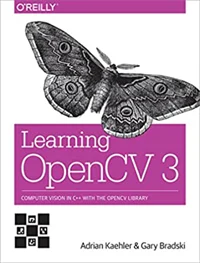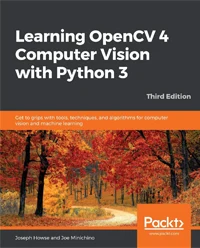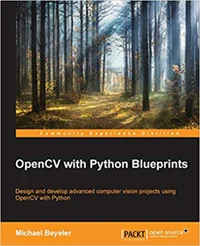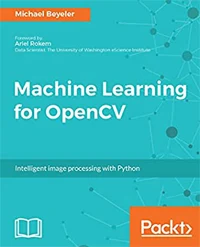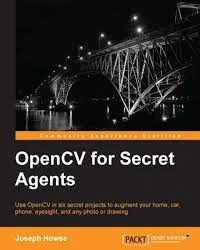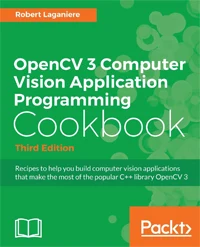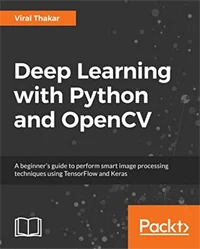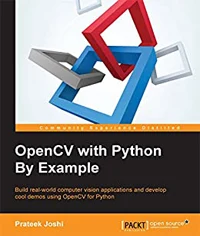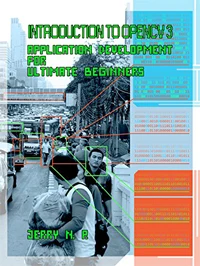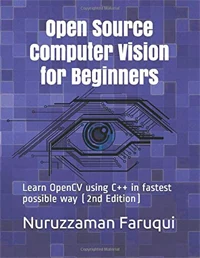Best Books to Learn OpenCV
FREE Online Courses: Dive into Knowledge for Free. Learn More!
In this article, we’ll be covering some of the books that give a general and advanced overview of OpenCV. We’ll be discussing the basic outline of the books and what all topics it covers. Let’s start!!
Best Open CV Books
1. Learning OpenCV 3.0 by Adrian Kaehler and Gary Bradski
OpenCV is utilized in various applications such as security, medical imaging, pattern and face recognition, robotics, and industrial product inspection since it has over 500 functions that span different image processing functions. This book provides a solid foundation in computer vision and OpenCV, allowing us to create basic or complex vision applications.
Learning OpenCV 3 is an excellent reference book that guides developers, and learners through the introduction to computer vision using OpenCV. It formulates a roadmap to learning OpenCV through practice. Learning OpenCV 3.0 places us at the forefront of the rapidly growing field of computer vision.
The authors of this book are the creators of the open-source OpenCV library, Adrian Kaehler and Gary Bradski. The book guides the developers through computer vision and shows how to easily construct applications that allow computers to “see” and make judgments based on the data they collect.
This book explores the whole OpenCV library, including machine learning tools for computer vision. The books guide the developers and thoroughly discusses topics such as
1. The fundamentals of OpenCV
2. Computer vision tasks
3. History of OpenCV
4. Installation and set up of OpenCV in different environments
5. Using Git to get the most recent version of OpenCV
6. Learning through OpenCV documentation
7. OpenCV data types, types of arrays, and operations on arrays
8. HighGUI utilization to capture and store still and video photos
9. Stretching, shrinking, distorting, remapping, and repairing image operations with image transformation
10. Investigating pattern recognition, particularly the detection of faces
11. Observing objects and motion in the visual field
12. Rebuilding 3D images from stereo vision
2. Learning OpenCV 4 Computer Vision with Python 3 by Joseph Howse and Joe Minichino
Computer vision is a rapidly expanding field that encompasses a wide range of techniques and applications. This book will benefit not only those who are just starting with computer vision but also those who are already specialists in the field. This book has been updated for OpenCV 4 and Python 3, covers the most recent developments in depth cameras, 3D tracking, augmented reality, and deep neural networks, and will help address real-world computer vision problems
Characteristics of the book are:
1. OpenCV 4 and Python 3 implementation to create powerful computer vision apps with minimal code.
2. Grasping the fundamental concepts of processing of images as the first step in computer vision objectives, object detection, recognition and extraction tasks, and 2D and 3D tracking of static and moving objects.
3. Training and executing machine learning models such as Support Vector Machines (SVMs) and Neural networks (convolution neural networks) by understanding the fundamental concepts of image processing.
The book introduces readers to OpenCV 4 and how to use it with Python 3 in various environments. Readers learn how to read, write, manipulate, and display still photos, videos, and camera feeds using simple operations. This book assures opportunities for hands-on exercises by guiding readers through image processing, video analysis, depth estimation, and segmentation, and helping developers get practice by constructing a GUI software.
The following topics have been covered in the book:
1. Downloading the Python 3 bindings for OpenCV 4 and familiarising with them.
2. Understanding the fundamentals of image processing and video analysis
3. Distinguishing between foreground and background regions using a depth Detection and classification of objects of interest in videos
4. Face detection and identification
5. Object classification and machine learning techniques
6. Tracking the motion of an object.
7. Training and executing models to detect, compare and classify objects
8. Building and using object detectors and classifiers and monitoring objects in the video camera feed.
9. 3D tracking and augmented reality implementations
10. Understanding ANNs and DNNs and their implementation
3. OpenCV with Python Blueprints by Michael Beyeler
OpenCV is a C++ library for computer vision, machine learning, and image processing that runs natively on all platforms. It’s becoming more popular in Python for computer vision development. OpenCV supports Windows, Linux, Mac, iOS, and Android and includes C++/C, Python, and Java interfaces. Developers that use OpenCV create apps that process visual data, such as live streaming data from a camera or images or videos. OpenCV has a large library of nearly 500 functions.
OpenCV with Python Blueprints is a fantastic book for anyone from a novice to a semi-advanced user of Python and OpenCV. It has a lot of good examples with important topics. This book demonstrates how to use Python to create real-world OpenCV applications. Basic Python programming expertise is anticipated and assumed prior to reading this book.
Rather than explaining the essential ideas of OpenCV in theoretical sessions, this book shows how to create a series of intermediate to advanced projects using OpenCV and Python. The working projects in this book, on the other hand, clearly demonstrate how to apply their theoretical understanding to subjects including image manipulation, augmented reality, object detection and tracking, 3D reconstruction, statistical modeling, and categorization of objects.
This book explores the whole OpenCV library, including machine learning tools for computer vision. The books guide the developers and thoroughly discusses topics such as
1. Use various filters and picture editing techniques such as dodging and burning to create real-time visual effects.
2. Make computer vision programs.
3. Multiple examples of image processing and machine learning for OpenCV.
4. Based on the output of a Microsoft Kinect sensor, recognize hand motions in real-time and perform hand-shape analysis.
5. Learn how to track arbitrary objects of interest using feature extraction and feature matching.
6. Recreate a 3D real-world scene using 2D camera motion and standard camera reprojection techniques.
7. Search for and focus on visually relevant portions of an image to track visually salient things.
8. Faces can be detected using a cascade classifier, and emotional emotions in human faces may be recognized using multi-layer perceptrons (MLPs)
9. Using a multi-class adaption of support vector machines, recognize street signage (SVMs)
4. Machine Learning for OpenCV: Intelligent image processing with Python by Michael Beyeler
OpenCV is a free software library for creating computer vision applications. OpenCV 4 is the most recent release, and it comes with many new features and platform enhancements that are extensively covered in this updated second edition. We’ll learn about the new capabilities and configure OpenCV 4 to create computer vision applications.
We’ll understand the principles of machine learning and how to create your image processing algorithms. The book will gradually introduce the readers to supervised and unsupervised machine learning. It progresses to explain how to use sci-kit-learn in Python to create a number of machine learning applications.
We explore other machine learning techniques, such as decision trees, support vector machines (SVM), and Bayesian learning, and how these might be used for object detection and computer vision. Then we’ll learn about deep learning and ensemble learning, as well as real-world applications like handwritten digit categorization and gesture detection.
The book starts by covering the fundamentals of statistical learning, such as classification and regression. After we’ve mastered the fundamentals, we’ll look at a range of techniques, including decision trees, support vector machines, and Bayesian networks, and understand how to integrate them with other OpenCV features.
As we continue, we improve our machine learning skills and learn about deep learning, one of the most essential concepts in the field. We understand how to implement a model to classify handwritten numerals using it. Finally, the book will consolidate what you’ve learned and show you how to use the techniques discussed in the chapters to solve machine learning challenges.
By the end of this book, we’ll have the knowledge and skills to tackle a variety of machine learning problems, whether by modifying existing source code or creating our method from the start.
It contains a thorough overview of machine learning fundamentals. This OpenCV book is an excellent resource for both Machine Learning and Computer Vision. Using OpenCV and Python, it loads, stores, edits, and visualizes data. Evaluate, compare, and select the best method for any task once more. Readers will be able to grasp the core ideas of classification, regression, and clustering after completing this book.
The book gradually guides the developers through the following topics:
1. Learning how to use OpenCV’s machine learning module and how to get the most out of it.
2. Implementing deep learning for computer vision modules with python.
3. Training and executing deep learning models for computer vision tasks.
4. Categorization of items like flower species, handwritten numbers, and pedestrians into categories.
5. Understanding the implementation and use of support vector machines, boosted decision trees, and random forests techniques.
6. Building solutions revolving around the real-world problem with neural networks.
7. Learning how to use data pre-processing and feature engineering to improve our results.
5. OpenCV for Secret Agents by Joseph Howse
OpenCV for Secret Agents is an excellent introduction to the features of OpenCV. It facilitates the development of OpenCV apps for the PC, Raspberry Pi, Android, and the Unity game engine. The book teaches how to classify photos in real-time, as well as to detect and recognize any person or animal, and examine motion and distance with superhuman precision.
OpenCV 4 is a software library that includes image processing and computer vision algorithms. It’s free and open-source, and it works with a variety of programming languages and platforms. It’s also fast enough for most real-time applications. Developers will be able to create a wide range of stunning devices with this useful library.
OpenCV 4 for Secret Agents includes a wide range of projects that use computer vision, machine learning, and a variety of application frameworks. The book supports many Python versions, ranging from 2.7 to 3.7, so apps can be created for a variety of desktop computers and Raspberry Pi. The book focuses on the exploration of topics through the implementation of projects.
Various projects are developed such as intelligent camera systems that evaluate barriers, people, and even animals will be able to defend your home and car. Developers learn how to train a search engine to praise or critique images it discovers, as well as how to create a smartphone app that speaks to you and responds to your body language.
The book indulges in interactive teaching by exploring topics such as:
1. On Windows, Mac, or Linux, install OpenCV, a Python development environment, and an Android development environment.
2. On Windows or Mac, set up a Unity development environment.
3. Controlling a phone app using gestures
4. Installing a rear-view camera and hazard detection mechanism in your vehicle monitored using OpenCV.
5. Creating hands-free interfaces for use in home automation, automobiles, and discreet surveillance.
6. Detection of car headlights, evaluation of their distances, and sending feedback to the driver.
7. Spotting and distinguishing human and animal faces.
8. In a real-time video, amplify motion so that a person’s heartbeat and breathing can be seen clearly.
9. Integration of OpenCV with other libraries and frameworks for graphical user interfaces and gaming.
6. OpenCV 3 Computer Vision Application Programming Cookbook by Robert Laganiere
This book helps developers understand the fundamentals of computer vision and image processing. With comprehensive working examples implemented, we learn about the major classes and functions of OpenCV.
OpenCV 3 Computer Vision Application Programming Cookbook, Third Edition is for new C++ programmers who wish to learn how to construct computer vision applications using the OpenCV library. It’s also appropriate for expert software engineers who want to learn about computer vision programming.
It can also be used as a textbook for computer vision courses at the university level. It’s a great resource for graduate students and researchers interested in image processing and computer vision.
In this book, the readers will go step by step through the following topics:
1. Installing OpenCV library
2. Manipulating the pixels of an image to perform various operations
3. Various image enhancement and form analysis algorithms will be demonstrated
4. Recognition of certain image features like lines, circles, and corners.
5. Analysis of images using histograms.
6. Understanding the principles of mathematical morphology and picture filtering
7. Extraction of relevant items from photos by segmenting them into homogeneous sections
8. Utilization of image geometry to relay diverse views of a photographed scene by using image filters to enhance image content
9. Calibration of the camera based on a variety of image observations
10. Implementation of Computer vision using machine learning algorithms
11. Recreation of a 3D scene with pictures using OpenCV to make applications
7. Deep Learning with Python and OpenCV: A beginner’s guide to perform smart image processing techniques using TensorFlow and Keras by Viral Thakar
Through this book, we’ll understand the essential ideas of image processing and computer vision using deep learning. The book guides the readers to develop their skills by learning how to use python libraries like NumPy, Matplotlib, TensorFlow, and Keras to create neural network models for computer vision tasks. It covers numerous aspects of deep learning.
This book targets machine learning developers, deep learning researchers, and AI enthusiasts who want to build efficient neural network models for image processing tasks.
Deep Learning is the buzzword and the new field in the world of IT that is bringing machine learning and artificial intelligence to life. Deep Learning with Python and OpenCV will introduce the flavor of deep learning in computer vision and image processing applications, while also explaining the necessary concepts such as back-propagation, perceptrons, and neural networks to lay the groundwork for the practical approach mentioned.
The book will begin by explaining the concept of Deep Learning, as well as its current trends and applications in computer vision and image processing. With real-world examples, we’ll learn how to use OpenCV and Python frameworks like TensorFlow and Keras to develop supervised, unsupervised, and reinforcement learning algorithms.
Through this book, we’ll understand how to:
1. Develop an understanding of deep learning-based algorithms to design deep neural network models.
2. Explore the machine learning and deep learning environment for computer vision and image processing applications.
3. Learn how to use Python, OpenCV, Tensorflow, and Keras to construct, train, and validate models for tasks including image recognition, image tagging, object detection, tracking, and segmentation.
4. Discover how to train and scale deep neural networks like CNN, RNN, and Capsule networks.
5. Integrate deep learning concepts in next-generation computer vision applications with reinforcement learning and GANs.
6. Deploy the prototypes that have been trained in a production-ready environment.
8. OpenCV with Python by Example by Prateek Joshi
This book will take readers step by step through all of the components required to create remarkable computer vision apps. We begin by transforming images with geometric changes. Then we’ll look at how to employ affine and projective transformations to create fascinating geometric effects on pictures.
The methodologies for object detection, 3D reconstruction, stereo imaging, and other computer vision applications will then be discussed. This book also includes straightforward Python examples for creating OpenCV applications.
The book begins with fundamental beginner-level tasks such as basic image processing and handling, picture mapping, and image detection. With the help of examples, it also covers popular OpenCV libraries. The book is a hands-on tutorial that takes us through a variety of examples at various levels, teaching you about OpenCV’s many functions and how to use them.
This book is for Python programmers who are new to OpenCV and want to use OpenCV-Python to create computer vision applications. This book can also be used by general software developers who want to install computer vision applications on the cloud. A rudimentary understanding of mathematical concepts such as vectors, matrices, and the like would be beneficial.
In this books, the following topics will be discussed
1. Applying geometric adjustments to photos, filter them, and turn them into cartoon-like images.
2. Detection and tracking features such as the face, nose, eyes, ears, and mouth, among other body parts.
3. Creating a panoramic image by stitching together numerous photographs of a scene.
4. Making an object vanish from a photograph
5. In a live video, recognition of different shapes, segment an image, and track an item.
6. Creating a visual search engine by recognizing an object in an image.
7. Recreating a 3D map with pictures
8. Construction of an augmented reality app
9. Introduction to OpenCV 3: Application Development for Ultimate Beginners by Jerry N. P.
This book will show the readers how to utilize the OpenCV 3 library (Open Computer Vision). C, C++, Java, and Python are all supported by the library. Through this book, the readers will learn how to use the library with C++, Java, and Python with this book.
The OpenCV library is used to demonstrate how to read, write, and store images. The technique of utilizing OpenCV to display images via a graphical user interface is discussed. We’ll understand various algorithms to transform our photos from one color code to another using OpenCV. The readers will also learn how to use OpenCV and the camera to detect faces.
When using OpenCV, we may perform a variety of geometric modifications on images. These are covered in-depth in this book, so the readers will know how to implement them in a variety of computer languages. We’ll also learn how to use OpenCV to analyze videos.
This book discusses the following topics:
1. What exactly is OpenCV?
2. Image Storage, Image Reading and Image Composition
3. Utilizing graphical user interface (GUI) for computer vision applications
4. Color Spaces, color models and Image Conversion
5. Image Geometric Transformations
6. Application of geometric adjustments to photos
7. Filtering methods in OpenCV
8. Video Evaluation and analysis
10. Open Source Computer Vision for Beginners: Learn OpenCV using C++ in the fastest possible way by Nuruzzaman Faruqui
It is a comprehensive guide on OpenCV, with an emphasis on applications rather than descriptions. Every application in this book includes ready-to-use C++ code as well as line-by-line explanations with visual help. In a word, this book is the finest introduction to OpenCV programming in C++ for novices.
Computer vision is ubiquitous in today’s technologies. OpenCV for Python can be used to run real-time computer vision algorithms. Because of the advancement of powerful technologies, we now have the greater processing capability to work with. Using this technology, we can easily connect our computer vision programs to the cloud.
Web developers may construct complex programs without having to reinvent the wheel. This book will walk you through all of the components needed to create amazing computer vision apps step by step. To begin, we use geometric changes to transform images. After that, we’ll look at how to use affine and projective transformations to generate interesting geometric effects on images.
1. Installing the OpenCV library is the first step.
2. Performing various actions on the pixels of an image
3. Algorithms for picture enhancement and form analysis will be demonstrated.
4. Image features such as lines, circles, and corners are recognized.
5. Using histograms to analyze images
6. Knowing the fundamentals of mathematical morphology and image filtering
7. Identifying significant elements in images by segmenting them into homogenous portions.
8. Using image filters to enhance image content, use image geometry to communicate several views of a photographed scene.
9. Using a range of image observations to calibrate the camera
10. Machine learning methods are used to implement computer vision.
11. Using OpenCV to create applications, recreate a 3D scene with photos.
Conclusion
In this article, we discussed some of the books on OpenCV to master the fundamentals and progress towards advanced topics. We discussed the core topics covered in the books. We covered books that focus on documentation-based approaches and books that indulge in interactive teaching using projects and implementations.
